A Ku-Band Compact Offset Cylindrical Reflector Antenna with High Gain for Low-Earth Orbit Sensing Applications
Abstract
:1. Introduction
2. Antenna Design
2.1. Antenna Specifications
2.2. Patch Array Feed
2.3. Cylindrical Reflector Antenna
3. Reflector Experimental Validation
4. Proposed Deployment of the Reflector
Future Work
5. Conclusions
Author Contributions
Funding
Institutional Review Board Statement
Informed Consent Statement
Data Availability Statement
Conflicts of Interest
References
- Besoya, M.; Govil, H.; Bhaumik, P. A review on surface deformation evaluation using multitemporal SAR interferometry techniques. Spat. Inf. Res. 2021, 29, 267–280. [Google Scholar] [CrossRef]
- Kwok, R. Arctic sea ice thickness, volume, and multiyear ice coverage: Losses and coupled variability (1958–2018). Environ. Res. Lett. 2018, 13, 105005. [Google Scholar] [CrossRef]
- IPCC. IPCC Special Report on the Ocean and Cryosphere in a Changing Climate. In Intergovernmental Panel on Climate Change; Pörtner, H.-O., Roberts, D.C., Masson-Delmotte, V., Zhai, P., Tignor, M., Poloczanska, E., Mintenbeck, K., Alegría, A., Nicolai, M., Okem, A., et al., Eds.; IPCC: Geneva, Switzerland, 2019. [Google Scholar]
- Diebold, F.X.; Rudebusch, G.D.; Göbel, M.; Coulombe, P.G.; Zhang, B. When will Arctic sea ice disappear? Projections of area, extent, thickness, and volume. J. Econom. 2023, 236, 105479. [Google Scholar] [CrossRef]
- Saeed, N.; Elzanaty, A.; Almorad, H.; Dahrouj, H.; Al-Naffouri, T.Y.; Alouini, M.-S. CubeSat Communications: Recent Advances and Future Challenges. IEEE Commun. Surv. Tutor. 2020, 22, 1839–1862. [Google Scholar] [CrossRef]
- Meirambekuly, N.; Karibayev, B.A.; Namazbayev, T.A.; Ibrayev, G.-G.A.E.; Orynbassar, S.O.; Ivanovich, S.A.; Temirbayev, A.A. A High Gain Deployable L/S Band Conical Helix Antenna Integrated with Optical System for Earth Observation CubeSats. IEEE Access 2023, 11, 23097–23106. [Google Scholar] [CrossRef]
- Zaman, I.U.; Behbahani, A.S.; Bayer, M.M.; Shaboyan, S.; Eltawil, A.; Boyraz, O. A Comparative Study of Inter CubeSat High Speed Links: RF, mmWave and Optical; University of California: Irvine, CA, USA, 2019; Tech. Rep. N00014-18-1-2845. [Google Scholar]
- Ramahatla, K.; Mosalaosi, M.; Yahya, A.; Basutli, B. Multiband Reconfigurable Antennas for 5G Wireless and CubeSat Applications: A Review. IEEE Access 2022, 10, 40910–40931. [Google Scholar] [CrossRef]
- Hussain, R.; Ikram, M.; Algarni, A.M.; Iqbal, S.S. Dual Sense Circularly Polarized Compact Slot Antenna for CubeSat Applications. IEEE Access 2022, 10, 111732–111737. [Google Scholar] [CrossRef]
- Chahat, N.; Decrossas, E.; Gonzalez-Ovejero, D.; Yurduseven, O.; Radway, M.J.; Hodges, R.E.; Estabrook, P.; Baker, J.D.; Bell, D.J.; Cwik, T.A.; et al. Advanced CubeSat Antennas for Deep Space and Earth Science Missions: A review. IEEE Antennas Propag. Mag. 2019, 61, 37–46. [Google Scholar] [CrossRef]
- Hwang, M.; Kim, G.; Kim, S.; Jeong, N.S. Origami-Inspired Radiation Pattern and Shape Reconfigurable Dipole Array Antenna at C-Band for CubeSat Applications. IEEE Antennas Propag. Mag. 2021, 69, 2697–2705. [Google Scholar] [CrossRef]
- Fernandez, L.; Sobrino, M.; Ruiz-De-Azua, J.A.; Calveras, A.; Camps, A. Design of a deployable helix antenna at L-band for a 1-unit CubeSat: From theoretical analysis to flight model result. Sensors 2022, 22, 3633. [Google Scholar] [CrossRef]
- Zhou, S.G.; Zhao, G.; Xu, H.; Luo, C.W.; Sun, J.Q.; Chen, G.T.; Jiao, Y.C. A Wideband 1-Bit Reconfigurable Reflectarray Antenna at Ku-Band. IEEE Antennas Wirel. Propag. Lett. 2022, 21, 566–570. [Google Scholar] [CrossRef]
- Chen, G.-T.; Jiao, Y.-C.; Zhao, G.; Luo, C.-W. Design of Wideband High-Efficiency Circularly Polarized Folded Reflectarray Antenna. IEEE Trans. Antennas Propag. 2021, 69, 6988–6993. [Google Scholar] [CrossRef]
- Chahat, N.; Sauder, J.; Mitchell, M.; Beidleman, N.; Freebury, G. One-Meter Deployable Mesh Reflector for Deep-Space Network Telecommunication at X -Band and Ka -Band. IEEE Trans. Antennas Propag. 2020, 68, 727–735. [Google Scholar] [CrossRef]
- Kamaliya, K.; Upadhyay, S.H. Inflatable antenna structures: Deployment analysis of torus bounded Z-fold scalable planar membrane reflector. Thin-Walled Struct. 2023, 191, 111061. [Google Scholar] [CrossRef]
- Xiong, S.; Xie, Z.; Qu, Q. Parabolic curved reflector antenna for spatial power combining. In Proceedings of the 2010 International Conference on Microwave and Millimeter Wave Technology, Chengdu, China, 8–11 May 2010; pp. 1020–1023. [Google Scholar]
- Mishra, G.; Sharma, S.K.; Chieh, J.-C.S.; Olsen, R.B. Ku-Band Dual Linear-Polarized 1-D Beam Steering Antenna Using Parabolic-Cylindrical Reflector Fed by a Phased Array Antenna. EEE Open J. Antennas Propag. 2020, 1, 57–70. [Google Scholar] [CrossRef]
- Rahmat-Samii, Y.; Huang, J.; Lopez, B.; Lou, M.; Im, E.; Durden, S.; Bahadori, K. Advanced precipitation Radar antenna: Array-fed offset membrane cylindrical reflector antenna. IEEE Trans. Antennas Propag. 2005, 53, 2503–2515. [Google Scholar] [CrossRef]
- Rahmat-Samii, Y.; Wang, J.; Zamora, J.; Freebury, G.; Hodges, R.E.; Horst, S.J. A 7 m × 1.5 m Aperture Parabolic Cylinder Deployable Mesh Reflector Antenna for Next-Generation Satellite Synthetic Aperture Radar. IEEE Trans. Antennas Propag. 2023, 71, 6378–6389. [Google Scholar] [CrossRef]
- Eom, S.Y.; Jung, Y.B.; Ganin, S.A.; Shishlov, A.V. A cylindrical shaped-reflector antenna with a linear feed array for shaping complex beam patterns. Prog. Electromagn. Res. 2011, 119, 477–495. [Google Scholar] [CrossRef]
- Nandan, V.; Scharien, R.K.; Geldsetzer, T.; Kwok, R.; Yackel, J.J.; Mahmud, M.S.; Rosel, A.; Tonboe, R.; Granskog, M.; Willatt, R.; et al. Snow Property Controls on Modeled Ku-Band Altimeter Estimates of First-Year Sea Ice Thickness: Case Studies from the Canadian and Norwegian Arctic. IEEE J. Sel. Top. Appl. Earth Obs. Remote Sens. 2020, 13, 1082–1096. [Google Scholar] [CrossRef]
- Isleifson, D.; Harasyn, M.L.; Landry, D.; Babb, D.; Asihene, E. Observations of Thin First Year Sea Ice using a Suite of Surface Radar, LiDAR, and Drone Sensors. Can. J. Remote Sens. 2023, 49, 2226220. [Google Scholar] [CrossRef]
- Bowman, A.; Kattegatsiak, D.; Ryznar, S.; Ransom, L.; Mir Ahmadi, S.; Asgari, A.; Sweeney, R.; Gill, R.; Nadan, V.; Esmail, B.; et al. ArcticSat: A CubeSat for Canada’s North, With Canada’s North. Logan, United States. 2024. Available online: https://digitalcommons.usu.edu/smallsat/2024/all2024/165/ (accessed on 23 November 2024).
- Chahat, N.; Hodges, R.E.; Sauder, J.; Thomson, M.; Peral, E.; Rahmat-Samii, Y. CubeSat deployable Ka-Band mesh reflector antenna development for earth science missions. IEEE Trans. Antennas Propag. 2016, 64, 2083–2093. [Google Scholar] [CrossRef]
- Chahat, N.; Hodges, R.; Sauder, E.J.; Thomson, M.; Rahmat-Samii, Y. The deep-space network telecommunication cubesat antenna: Using the deployable Ka-band mesh reflector antenna. IEEE Antennas Propag. Mag. 2017, 59, 31–38. [Google Scholar] [CrossRef]
- Yoon, S.S.; Lee, J.W.; Lee, T.-K.; Roh, J.H. Insensitivity characteristics in the dual polarization of deployable CFRP reflector antennas for SAR. IEEE Antennas Propag. Mag. 2018, 66, 88–95. [Google Scholar] [CrossRef]
- Pour, Z.A.; Shafai, L. Investigation of Virtual Array Antennas with Adaptive Element Locations and Polarization Using Parabolic Reflector Antennas. IEEE Trans. Antennas Propag. 2013, 61, 688–699. [Google Scholar] [CrossRef]
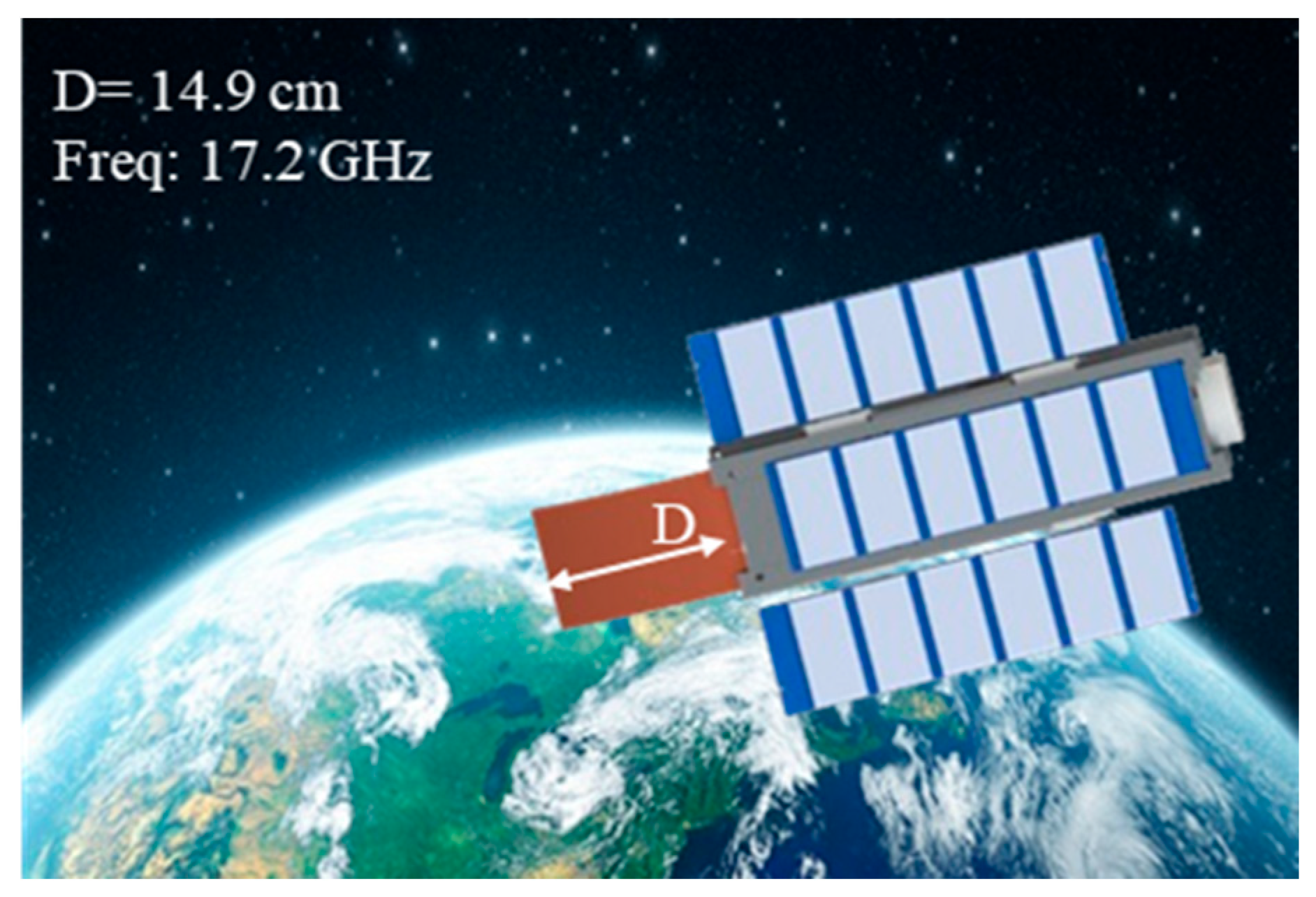

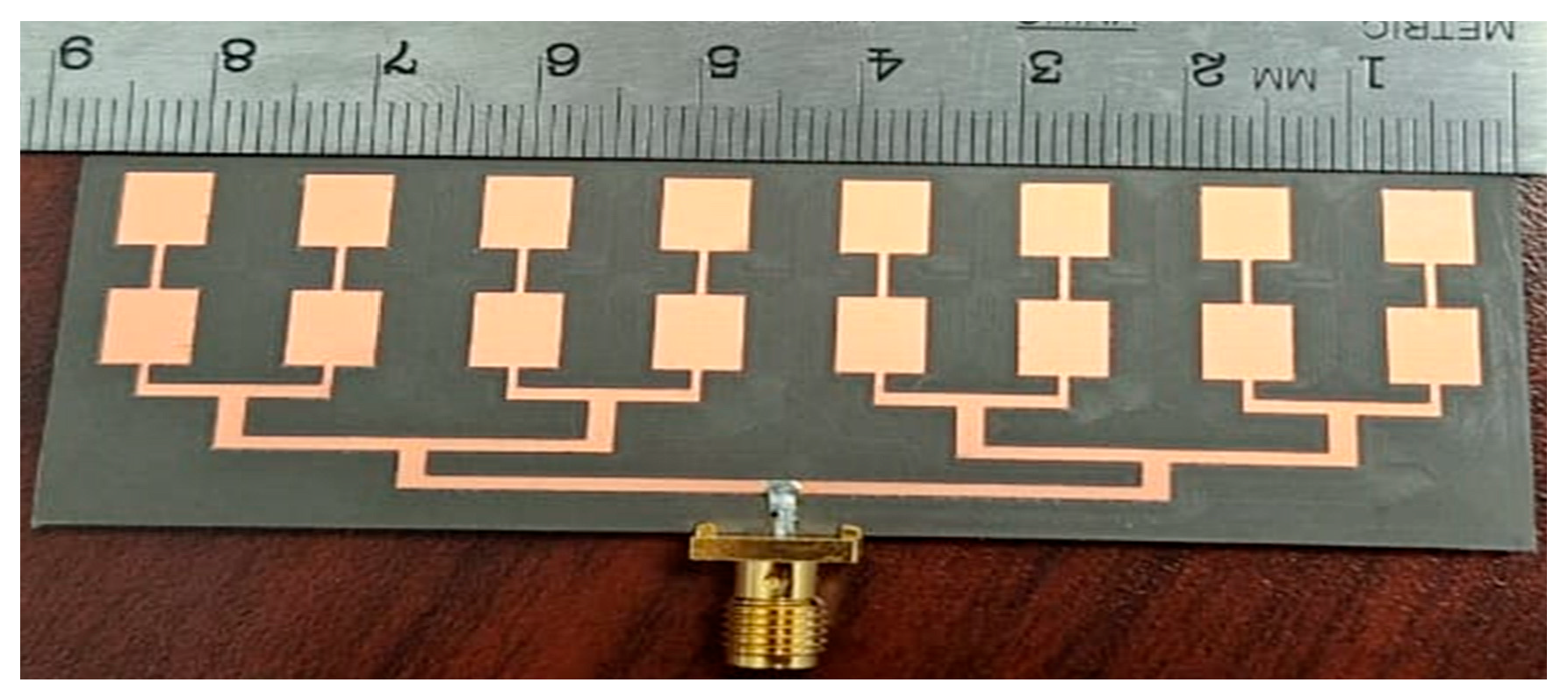
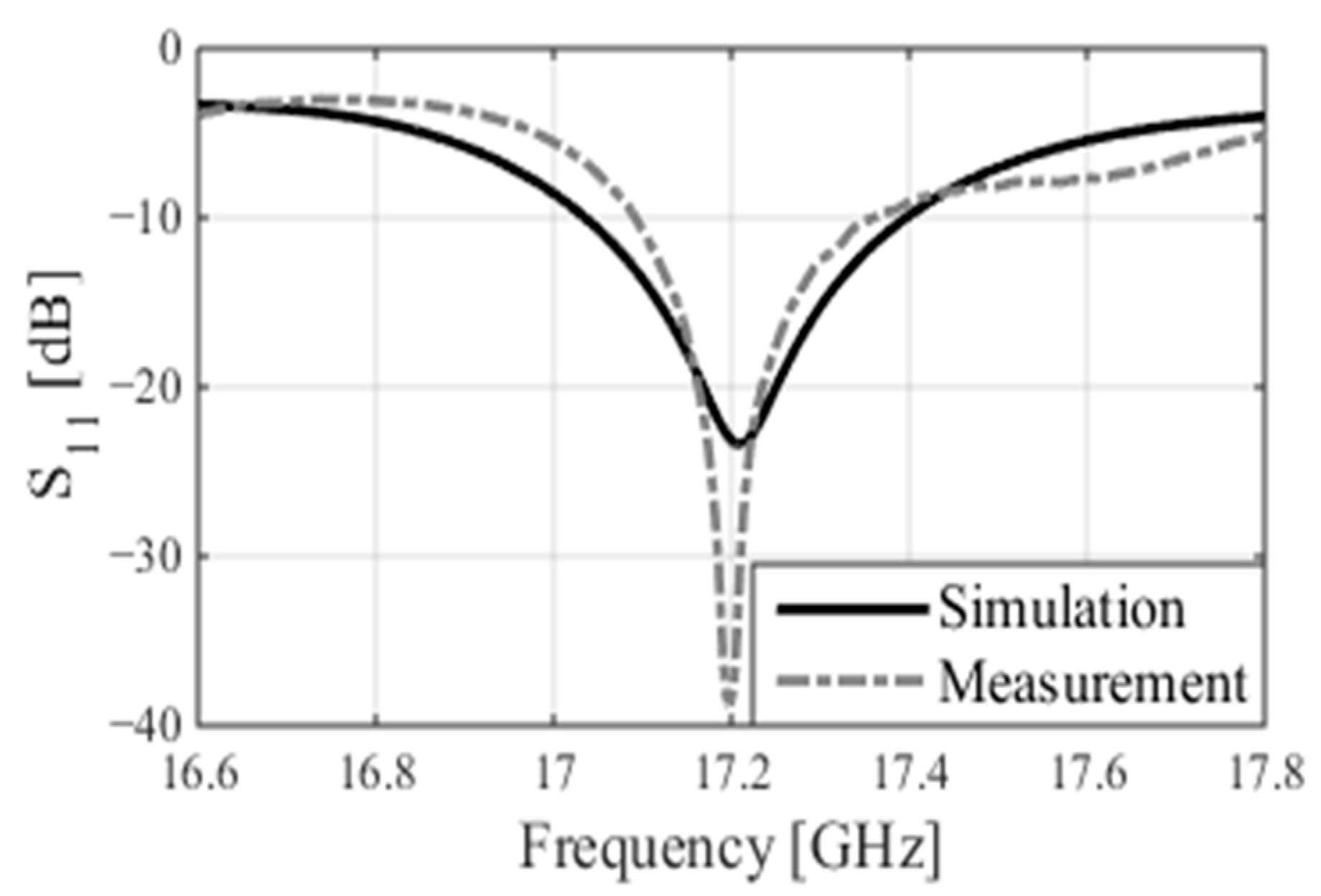


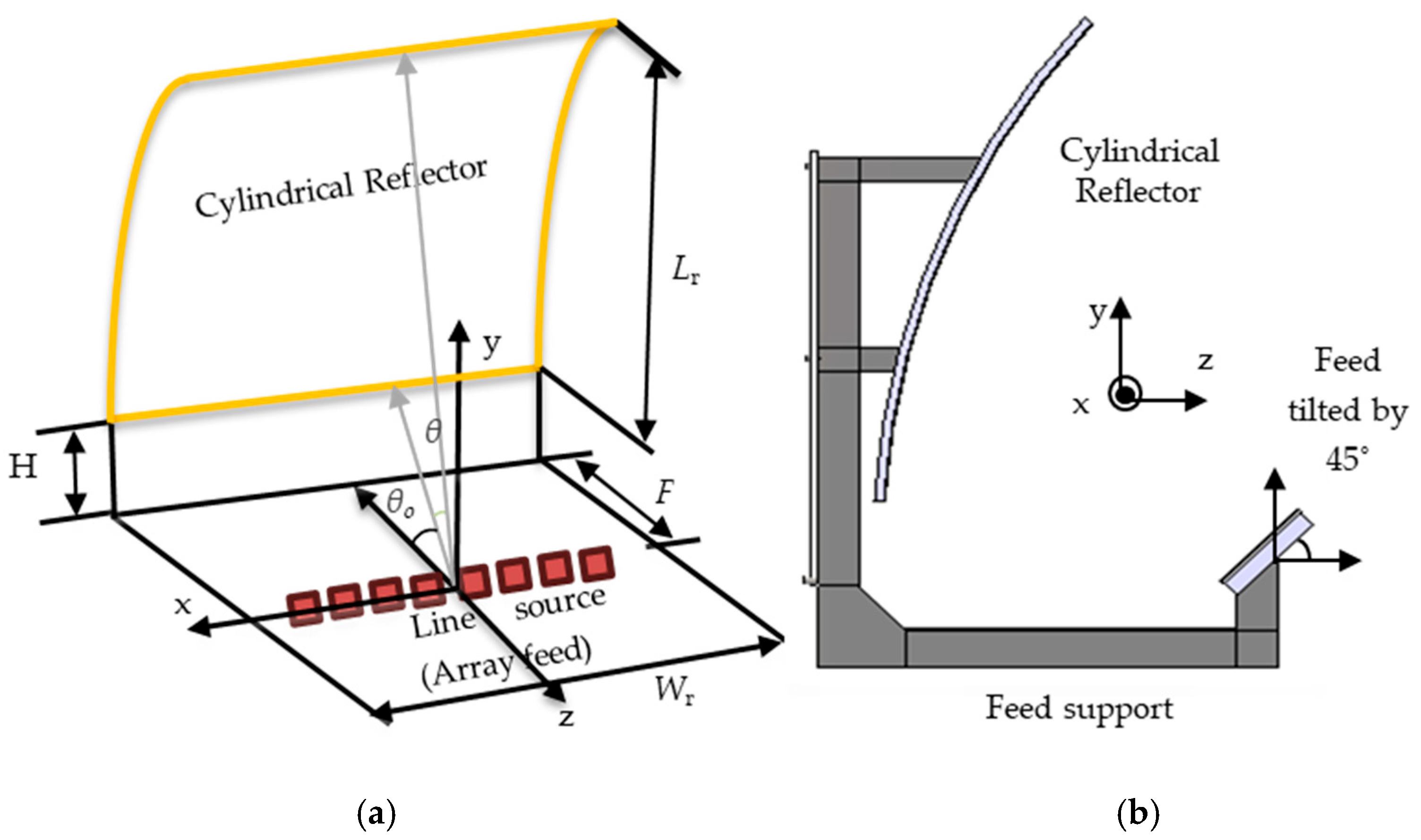

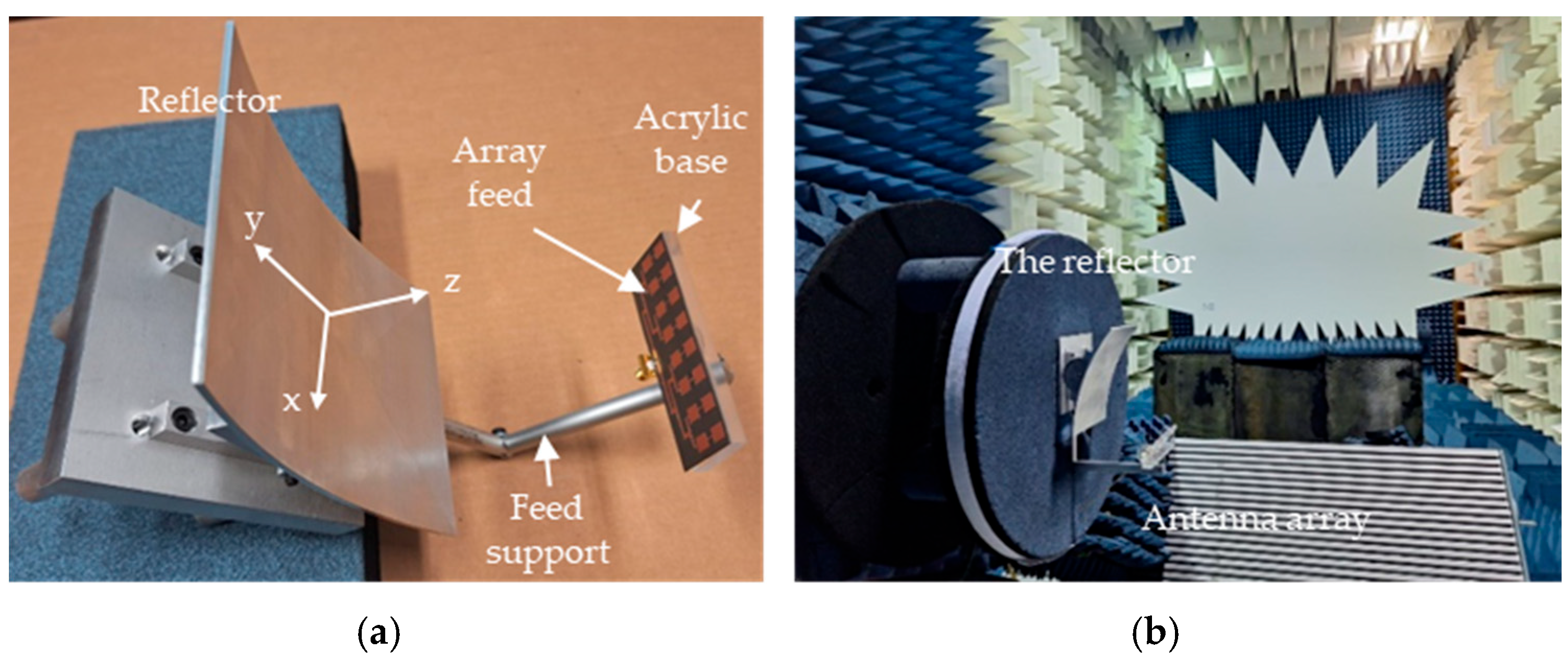

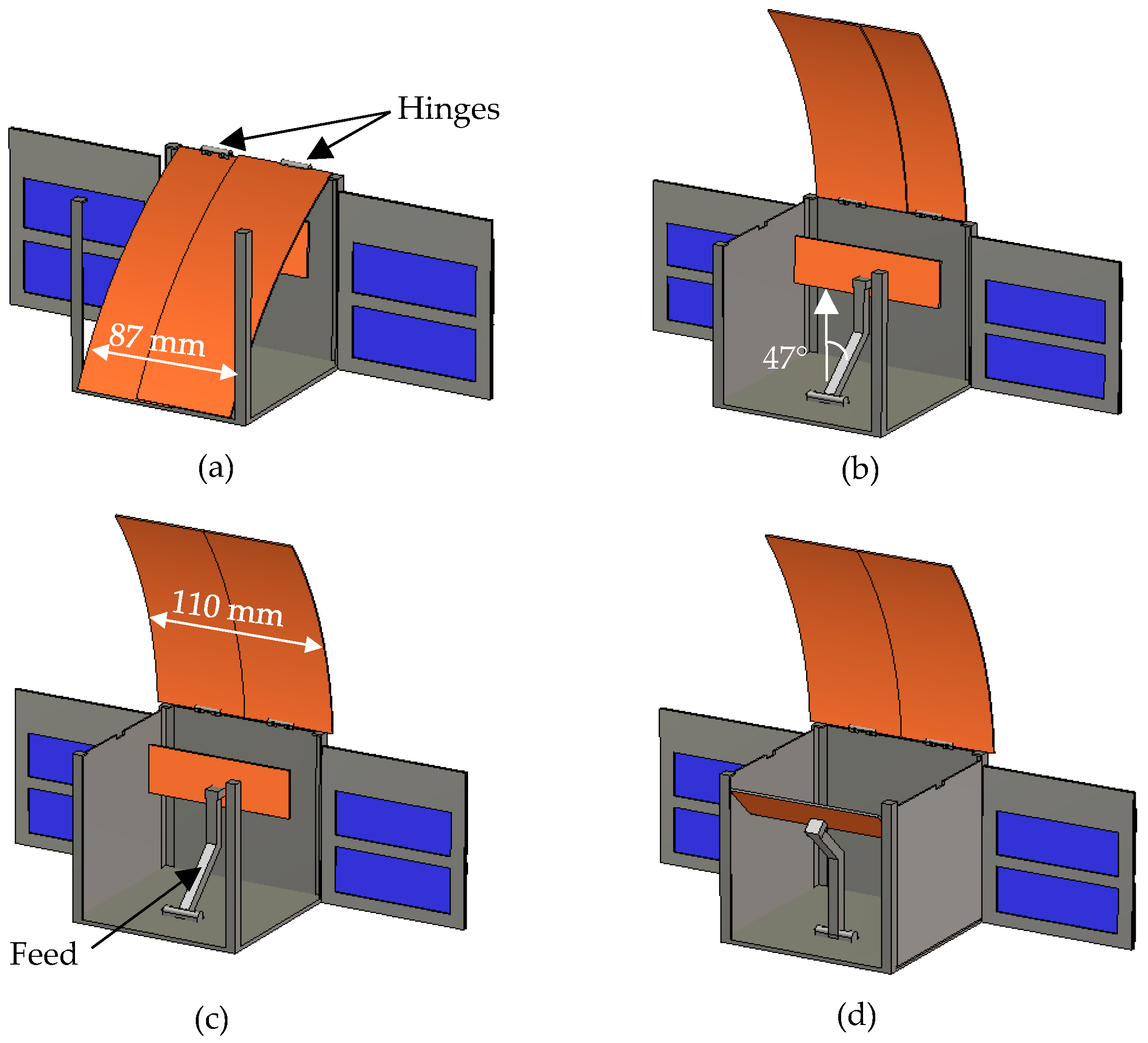
| Parameter | Value | Parameter | Value |
|---|---|---|---|
| Frequency | 17.2 GHz | Return loss | 20 dB |
| Polarization | Linear | Antenna gain | 25 dBi |
| Bandwidth | 200 MHz | Stowed | 10 × 10 × 10 cm3 |
| L | W | LP | WP | W1 | W2 | W3 | d | d1 | d2 | L1 | L2 | L3 | L4 | L5 |
|---|---|---|---|---|---|---|---|---|---|---|---|---|---|---|
| 88 | 29 | 5.3 | 5.1 | 1.5 | 0.95 | 0.47 | 45 | 23.6 | 11.5 | 3.1 | 2.9 | 3.1 | 2.5 | 3.62 |
| Plane | Gain (dBi) | Xpol (dB) | SLL (dB) | HPBW | ||||
|---|---|---|---|---|---|---|---|---|
| Sim. | Meas. | Sim. | Meas. | Sim. | Meas. | Sim. | Meas. | |
| E | 25 | 24.5 | −31.5 | −26.6 | −16 | −15.4 | 8° | 8.2° |
| H | 25 | 24.47 | −32.2 | −28.1 | −14 | −16 | 9.6° | 9.7° |
Disclaimer/Publisher’s Note: The statements, opinions and data contained in all publications are solely those of the individual author(s) and contributor(s) and not of MDPI and/or the editor(s). MDPI and/or the editor(s) disclaim responsibility for any injury to people or property resulting from any ideas, methods, instructions or products referred to in the content. |
© 2024 by the authors. Licensee MDPI, Basel, Switzerland. This article is an open access article distributed under the terms and conditions of the Creative Commons Attribution (CC BY) license (https://creativecommons.org/licenses/by/4.0/).
Share and Cite
Esmail, B.A.F.; Isleifson, D.; Shafai, L. A Ku-Band Compact Offset Cylindrical Reflector Antenna with High Gain for Low-Earth Orbit Sensing Applications. Sensors 2024, 24, 7535. https://doi.org/10.3390/s24237535
Esmail BAF, Isleifson D, Shafai L. A Ku-Band Compact Offset Cylindrical Reflector Antenna with High Gain for Low-Earth Orbit Sensing Applications. Sensors. 2024; 24(23):7535. https://doi.org/10.3390/s24237535
Chicago/Turabian StyleEsmail, Bashar A. F., Dustin Isleifson, and Lotfollah Shafai. 2024. "A Ku-Band Compact Offset Cylindrical Reflector Antenna with High Gain for Low-Earth Orbit Sensing Applications" Sensors 24, no. 23: 7535. https://doi.org/10.3390/s24237535
APA StyleEsmail, B. A. F., Isleifson, D., & Shafai, L. (2024). A Ku-Band Compact Offset Cylindrical Reflector Antenna with High Gain for Low-Earth Orbit Sensing Applications. Sensors, 24(23), 7535. https://doi.org/10.3390/s24237535







